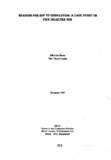Reasons for RDP VO dissolution: a case study on five selected VOs
Citation
Banu, D., & Amin, M. N. (1997, December). Reasons for RDP VO dissolution: a case study on five selected VOs. Research Reports (1997): Economic Studies, Vol - XII, 360–386.Abstract
During preparatory work for the Second Impact Assessment Study (lAS -ll) in 1996,
it was found that 18 VOs (8 women and 10 men) were not functioning out of 150 which were
studied for the lAS -I. As BRAC wanted the VOs to sustain and eventually develop as
institutions, it was felt that the reasons for their non-functioning should be investigated. The
present study was undertaken with that aim in view.
In consultation with RDP, five dissolved VOs (B, C and D for women, and A and E
for men) which had been dissolved during the previous year, from five area offices, were
selected purposively. The study used data which were derived both from primary and
secondary sources. To obtain primary information, the study relied mainly on selected RRAC
exercises including Time line, Problem tree, Mini-swvey, Social mapping and Kinship relation.
VO members and local BRAC staff were interviewed through a semi-structured checklist
Secondary information, relevant for the study, were collected from both Head Office and Area
Offices. The following gives the summary results:
The main reason for the dissolution of VO A was the withdrawal of the power tiller
which the VO had purchased with BRAC loan. This was done to adjust the loans which had
become overdue. BRAC's strategy to concentrate on female membership provided
justification for it
Strong kinship netwod played a vital role in dissolving VO B. More than two-third
members of this VO were from one kin group. When some of the members of this group
became defaulter VO management committee did not extend its cooperation to BRAC to take
necessary disciplinary action. Finding no other way local BRAC management had to dissolve
the VO.
Faction regarding VGD cards made VO C inactive. A dispute arose about selection of
VGD card holders when the president of the VO and the respective BRAC staff made the
selection ignoring the opinion of other members. Some cut down several hundreds of
mulbeny trees in the locality. The caretaker of the mulberry trees called police with the help of
BRAC and threatened some of the members. Members were divided into two groups and the
VO became non-functioning. VO D was poorly organized since its inception. Members of this VO were scattered at
different comers of the village. Some members had become defaulters and left the village.
New loan was not disbursed as there were overdue loans in the VO. Members became
inactive and the VO dissolved
VO E was formed with migrating people who frequently go to o1.1:side of the village for
their livelihoods. During 1988 flood most of the: members became defaulter as they failed to
~ their business and migrated to other district towns. BRAC tried to follow their overdue loans with the help of other VO members but could not manage to coilect. Thus the VO
became non-functioning and finally dissolved. The strength of the dissolved VOs was that these were formed with mostly
homogeneous people (80% of <50 decimals land group) which might help members to make
the VO cohesive and to develop a sense of ownership of the VO among them. In each of the
VOs there were a group of dedicated members who wanted to keep the VOs functioning. The
weakness of the VOs was that except credit, other activities of the VO which increase
awareness of the members, group cohesiveness, and V 0 discipline were overlooked. There
were some loan defaulters from whom BRAC could not collect money and consequently
stopped disbursing new loan. As a result, the regular members of the VOs also became
inactive. It seems that most of the members tried to use V 0 as an instrument for getting credit
There were some VO members who made regular loan repayments but BRAC was
unable to use them to keep the VO operational. It is interesting to mention that 27% of
member households of the study VOs are now involved with other NGOs and they are
reportedly performing wen. Members complained against the management system of BRAC
for dissolution of their VOs. According to them BRAC did not try to solve the problem of
overdue loan rather stopped disbursing new loans to the members who were not defaulters.
Thus most of the members lost their interest to be involved with BRAC. It seems BRAC
accepted dissolution of some of the VOs. Two of the study VOs were dissolved perhaps due
to the policy change of RDP about exclusion of male VOs.
The study suggests that BRAC should review the overdue loan collection and record
keeping system where there will be no opportunity for members to complain against improper.
record keeping on instalment payment. Frequent transfer of P A, which reportedly made ways
for defalcation of members' money, created dissatisfaction of members to BRAC rules. In
case of transfer of P A enough time should be given so that the P A can hand over the accounts
and other responsibilities to the new staff properly. The main conclusion the study has drawn
from the above analysis is BRAC can continue the inactive VOs excluding the defaulters and if
necessary, some new members can join the VO to fill up the gaps.

